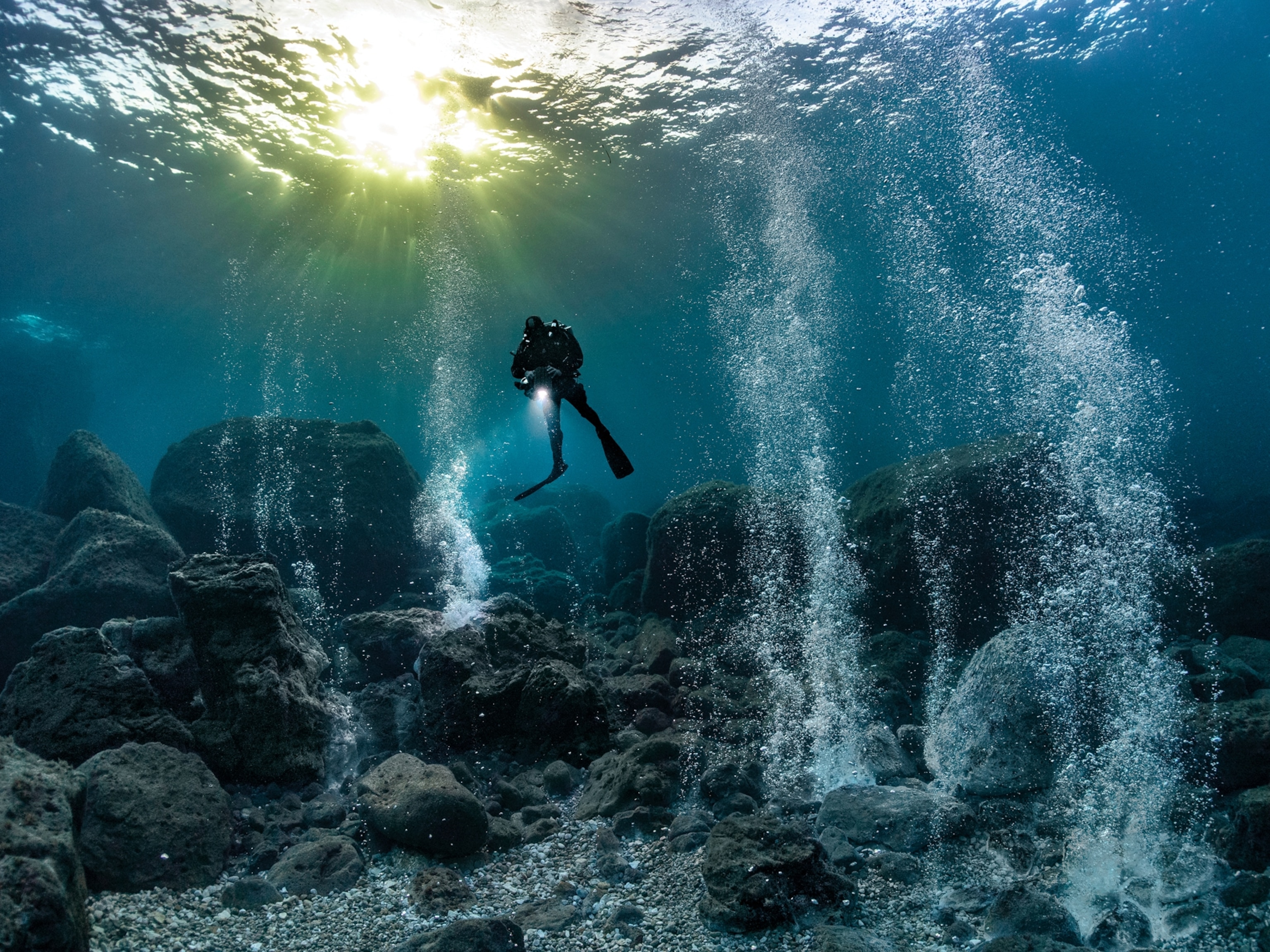In 2016, Ray Dalio, an investment fund manager, bought a ship designed to sturvey the ocean floor to search for oil. Now, as part of his OceanX initiative, the vessel is making its debut as one of the most decked-out venues for advancing our understanding of the deep sea.
Unveiled this week in a new video provided exclusively to National Geographic, the OceanXplorer has been retrofitted over the past four years to double as a cutting-edge research center and a media production studio. The 286-foot-long ship has been modified to house a helicopter landing pad and climate-controlled hangar, a 40-ton crane, three submersibles, onboard DNA sequencing, and other scientific gear. In addition, the ship will have the ability to take high-quality images at unprecedented depths. An underwater modem will allow these images to be livestreamed around the world from thousands of feet under the sea.
“The ship OceanXplorer will take ocean explorers to never-before-seen undersea worlds and allow them to beam back what they encounter via social media, digital experiences, and a TV show,” Dalio says in a news release. “It will be mind-blowing.”
The hope is that the OceanXplorer will bring together scientific experts and talented storytellers to make the case as Dalio puts it, “that ocean exploration is both more important and more exciting than space exploration.”
Fresh from a field test in Norway, the vessel is currently in the Red Sea off the coast of the Arabian Peninsula. There, the crew is preparing for an inaugural mission to study so-called super corals, which have the ability to recover and successfully reproduce after severe stress caused by phenomena such as ocean warming.
In an upcoming National Geographic series, National Geographic Explorer-at-Large James Cameron and filmmakers with BBC Studios will follow the OceanXplorer and its crew around the world as they study different parts of the ocean. “It’s going to enable me, other filmmakers, scientists, explorers, to just get out there and find things that we truly don’t know are there yet,” Orla Doherty, executive producer of BBC Studios, says in a video that was released earlier this year, which was also produced by Dalio’s ocean exploration initiative.
You May Also Like
Go Further
Animals
- This ‘saber-toothed’ salmon wasn’t quite what we thoughtThis ‘saber-toothed’ salmon wasn’t quite what we thought
- Why this rhino-zebra friendship makes perfect senseWhy this rhino-zebra friendship makes perfect sense
- When did bioluminescence evolve? It’s older than we thought.When did bioluminescence evolve? It’s older than we thought.
- Soy, skim … spider. Are any of these technically milk?Soy, skim … spider. Are any of these technically milk?
- This pristine piece of the Amazon shows nature’s resilienceThis pristine piece of the Amazon shows nature’s resilience
Environment
- This pristine piece of the Amazon shows nature’s resilienceThis pristine piece of the Amazon shows nature’s resilience
- Listen to 30 years of climate change transformed into haunting musicListen to 30 years of climate change transformed into haunting music
- This ancient society tried to stop El Niño—with child sacrificeThis ancient society tried to stop El Niño—with child sacrifice
- U.S. plans to clean its drinking water. What does that mean?U.S. plans to clean its drinking water. What does that mean?
History & Culture
- Séances at the White House? Why these first ladies turned to the occultSéances at the White House? Why these first ladies turned to the occult
- Gambling is everywhere now. When is that a problem?Gambling is everywhere now. When is that a problem?
- Beauty is pain—at least it was in 17th-century SpainBeauty is pain—at least it was in 17th-century Spain
- The real spies who inspired ‘The Ministry of Ungentlemanly Warfare’The real spies who inspired ‘The Ministry of Ungentlemanly Warfare’
- Heard of Zoroastrianism? The religion still has fervent followersHeard of Zoroastrianism? The religion still has fervent followers
Science
- Here's how astronomers found one of the rarest phenomenons in spaceHere's how astronomers found one of the rarest phenomenons in space
- Not an extrovert or introvert? There’s a word for that.Not an extrovert or introvert? There’s a word for that.
- NASA has a plan to clean up space junk—but is going green enough?NASA has a plan to clean up space junk—but is going green enough?
- Soy, skim … spider. Are any of these technically milk?Soy, skim … spider. Are any of these technically milk?
- Can aspirin help protect against colorectal cancers?Can aspirin help protect against colorectal cancers?
Travel
- What it's like to hike the Camino del Mayab in MexicoWhat it's like to hike the Camino del Mayab in Mexico
- Follow in the footsteps of Robin Hood in Sherwood ForestFollow in the footsteps of Robin Hood in Sherwood Forest
- This chef is taking Indian cuisine in a bold new directionThis chef is taking Indian cuisine in a bold new direction
- On the path of Latin America's greatest wildlife migrationOn the path of Latin America's greatest wildlife migration
- Everything you need to know about Everglades National ParkEverything you need to know about Everglades National Park




